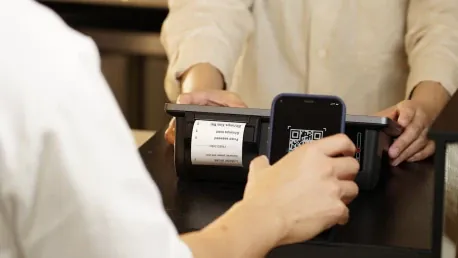Alipay has introduced a groundbreaking payment function, Tap!, designed to challenge the dominant QR code-based mobile payment system in China. This innovative feature leverages near-field communication (NFC) technology, enabling consumers to make payments simply by placing their phones near a specially installed reader. This marks a dramatic departure from the QR code-based transactions that currently account for an overwhelming 93% of mobile payments in China. While NFC technology is widely used in many global markets, previous attempts to introduce similar alternatives, such as face-recognition systems and UnionPay’s QuickPass, have not found lasting success in China.
Alipay’s Aggressive Promotion of Tap!
Since its launch in July, Alipay has been relentless in its efforts to promote Tap! both online and offline. The company has rolled out extensive campaigns to support the transition, offering technical assistance, store subsidies, and enticing consumer discounts. By early November, Tap! had become operational in over 1,000 shopping malls and commercial centers spanning more than 50 cities. Alipay’s substantial investment in this initiative is underscored by deploying a dedicated team of at least 1,000 individuals to install 1 million terminal devices within six months.
Zhang Zhan from Alipay’s outreach team has highlighted that the company not only equips merchants with NFC sensors but also provides incentives of up to 1 yuan per transaction for cashiers who help promote the service, with a daily cap of 300 yuan. In Shanghai, grocery store owner Shan Luhui shared positive experiences with Tap!, noting faster checkout times and increased customer attraction through random discounts. This aggressive promotion strategy showcases Alipay’s determination to revolutionize the mobile payment landscape and introduce consumers to a more streamlined and secure payment method.
Merchant and Customer Reactions
Despite the initial excitement, some merchants have expressed concerns about the overnight wait for fund transfers, which contrasts sharply with the instant transfers typical of QR code transactions. This delay can put considerable pressure on cash flow, potentially discouraging long-term adoption of Tap! by merchants. On the consumer side, factors such as convenience, reliability, and security significantly influence their willingness to switch from QR codes.
For instance, Zhu Yu, a 27-year-old lawyer, appreciated Tap!’s simplicity and the waiver of her 84-yuan grocery bill as a first-time user. Nonetheless, she expressed reservations about the potential risks of allowing password-free payments and the possibility of fraud. To address these concerns, Alipay has implemented a requirement that transactions via Tap! can only be completed after unlocking the phone. Furthermore, password-free payments are enabled solely for small amounts, requiring manual approval for more substantial transactions. These measures aim to enhance consumer confidence in the new system and mitigate fears surrounding fraud and security breaches.
Security and Technological Considerations
Liu Yuanju, a researcher at the Shanghai Institute of Finance and Law, emphasized that NFC technology offers greater security than QR codes. He explained that the encryption of data transmitted via NFC makes it significantly harder for fraudsters to intercept and manipulate compared to QR codes, which are more susceptible to malicious replacements. Despite ongoing debates about NFC and QR code technologies in China, several factors—including low credit card usage, the rise of mobile internet, and tech companies’ integrated business models—have cemented the widespread success of QR codes.
Ant Group has clarified that while Tap! is perceived as NFC-powered, it is essentially a variation of QR code transactions. The system converts a smartphone into an NFC tag reader and completes the transaction online via the Alipay app. This approach differs from traditional NFC payments such as those offered by Apple Pay and Samsung Pay, which emulate bank cards stored within the phone’s NFC chip. By adopting this unique method, Alipay ensures compatibility with various devices, including iOS and Android smartphones, making Tap! accessible to a broad user base.
Compatibility and Market Penetration
Alipay’s method also accommodates iOS devices, as iPhone’s card emulation mode is exclusive to Apple Pay. While Android users can use Tap! seamlessly, iPhone users must verify their transactions within the Alipay app. Liu noted that, historically, the low penetration of NFC-enabled phones was a significant barrier to the adoption of NFC technology in China. However, with over 80% of smartphones in the country now supporting NFC hardware, the potential for expanded market usage of NFC technologies has increased considerably.
Despite this, Liu predicts that QR codes and NFC will complement each other rather than act as direct competitors. For example, QR codes are better suited for situations requiring long-distance scans, such as paying at a parking lot exit, while NFC is ideal for close-proximity interactions. This complementary relationship could enable both technologies to coexist peacefully, each serving specific needs within the diverse Chinese mobile payment ecosystem.
The Future of Tap! in China’s Mobile Payment Landscape
Alipay has launched a revolutionary payment feature called Tap!, aiming to challenge China’s prevalent QR code-based mobile payment system. This pioneering function utilizes near-field communication (NFC) technology, allowing users to complete transactions merely by bringing their phone close to a specially installed reader. This is a significant shift from the current dominant setup, where QR code transactions make up an astounding 93% of mobile payments in China. Although NFC technology is popular and regularly used in many countries around the world, previous efforts to introduce alternative payment methods like face-recognition systems and UnionPay’s QuickPass in China have not seen lasting success. Tap! by Alipay might be the innovation that reshapes the mobile payment landscape in the nation, leveraging global trends and advanced technology to enhance convenience and security for users. This new feature indicates a forward-thinking move towards modernization in a field long dominated by QR codes.









